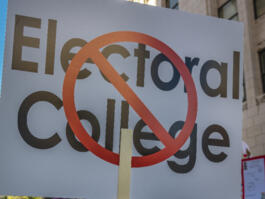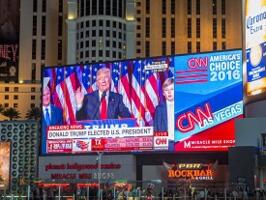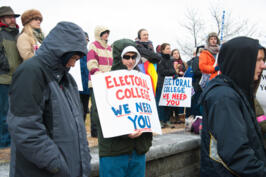Going Out on a Limb: Romney Beats Obama, Handily
A Commentary By Michael Barone
Fundamentals usually prevail in American elections. That's bad news for Barack Obama. True, Americans want to think well of their presidents, and many think it would be bad if Americans were perceived as rejecting the first black president.
But it's also true that most voters oppose Obama's major policies and consider unsatisfactory the very sluggish economic recovery -- Friday's job report showed an unemployment uptick.
Also, both national and target state polls show that independents -- voters who don't identify themselves as Democrats or Republicans -- break for Romney.
That might not matter if Democrats outnumbered Republicans by 39 to 32 percent, as they did in the 2008 exit poll. But just about every indicator suggests that Republicans are more enthusiastic about voting -- and about their candidate -- than they were in 2008, and Democrats are less so.
That's been apparent in early or absentee voting, where Democrats trail their 2008 numbers in target states Virginia, Ohio, Iowa and Nevada.
The Obama campaign strategy, from the beginning, has recognized these handicaps, running barrages of early anti-Romney ads in states that Obama carried narrowly. But other states, not so heavily barraged, have come into contention.
Which candidate will get the electoral votes of the target states? I'll go out on a limb and predict them, in ascending order of 2008 Obama percentages -- fully aware that I'm likely to get some wrong.
Indiana (11 electoral votes). Uncontested. Romney.
North Carolina (15 electoral votes). Obama has abandoned this target. Romney.
Florida (29). The biggest target state has trended Romney since the Denver debate. I don't see any segment of the electorate favoring Obama more than in 2008, and I see some (South Florida Jews) favoring him less. Romney.
Ohio (18). The anti-Romney auto bailout ads have Obama running well enough among blue collar for him to lead most polls. But many polls anticipate a more Democratic electorate than 2008. Early voting tells another story, and so does the registration decline in Cleveland's Cuyahoga County. In 2004, intensity among rural, small town and evangelical voters, undetected by political reporters who don't mix in such circles, produced a narrow Bush victory. I see that happening again. Romney.
Virginia (13). Post-debate polling mildly favors Romney, and early voting is way down in heavily Democratic Arlington, Alexandria, Richmond and Norfolk. Northern Virginia Asians may trend Romney. Romney.
Colorado (9). Unlike 2008, registered Republicans outnumber registered Democrats, and more Republicans than Democrats have voted early. The Republican trend in 2010 was squandered by weak candidates for governor and senator. Not this time. Romney.
Iowa (6). The unexpected Romney endorsements by the Des Moines Register and three other newspapers gave voice to buyer's remorse in a state Obama carried by 10 points. Democrats' traditional margin in early voting has declined. Romney.
Minnesota (10). A surprise last-minute media buy for the Romney campaign. But probably a bridge too far. Obama.
New Hampshire (4). Polls are very tight here. I think superior Republican intensity will prevail. Romney.
Pennsylvania (20). Everyone would have picked Obama two weeks ago. I think higher turnout in pro-coal western Pennsylvania and higher Republican percentages in the Philadelphia suburbs could produce a surprise. The Romney team evidently thinks so too. Their investment in TV time is too expensive to be a mere feint, and as this is written, Romney is planning a Sunday event in Bucks County outside Philly. Wobbling on my limb, Romney.
Nevada (6). Democratic early voting turnout is down from 2008 in Las Vegas' Clark County, 70 percent of the state. But the casino unions' turnout machine on Election Day re-elected an unpopular Harry Reid in 2010, and I think they'll get enough Latinos and Filipinos out this time. Obama.
Wisconsin (10). Recent polling is discouraging for Republicans. But Gov. Scott Walker handily survived the recall effort in June with a great organizational push. Democrats depend heavily on margins in inner-city Milwaukee (population down) and the Madison university community. But early voting is down in university towns in other states. The Obama campaign is prepared to turn out a big student vote, but you don't see many Obama signs on campuses. Romney.
Oregon (7), New Mexico (5), New Jersey (14). Uncontested. Obama.
Michigan (16). Romney chose Pennsylvania, where there's no auto bailout issue. Obama.
Bottom line: Romney 315, Obama 223. That sounds high for Romney. But he could drop Pennsylvania and Wisconsin and still win the election.
Fundamentals.
Michael Barone, senior political analyst for The Washington Examiner, is a resident fellow at the American Enterprise Institute, a Fox News Channel contributor and a co-author of The Almanac of American Politics.
COPYRIGHT 2012 THE WASHINGTON EXAMINER
DISTRIBUTED BY CREATORS.COM
See Other Political Commentaries.
See Other Commentaries by Michael Barone.
Views expressed in this column are those of the author, not those of Rasmussen Reports. Comments about this content should be directed to the author or syndicate.
Rasmussen Reports is a media company specializing in the collection, publication and distribution of public opinion information.
We conduct public opinion polls on a variety of topics to inform our audience on events in the news and other topics of interest. To ensure editorial control and independence, we pay for the polls ourselves and generate revenue through the sale of subscriptions, sponsorships, and advertising. Nightly polling on politics, business and lifestyle topics provides the content to update the Rasmussen Reports web site many times each day. If it's in the news, it's in our polls. Additionally, the data drives a daily update newsletter and various media outlets across the country.
Some information, including the Rasmussen Reports daily Presidential Tracking Poll and commentaries are available for free to the general public. Subscriptions are available for $4.95 a month or 34.95 a year that provide subscribers with exclusive access to more than 20 stories per week on upcoming elections, consumer confidence, and issues that affect us all. For those who are really into the numbers, Platinum Members can review demographic crosstabs and a full history of our data.
To learn more about our methodology, click here.



